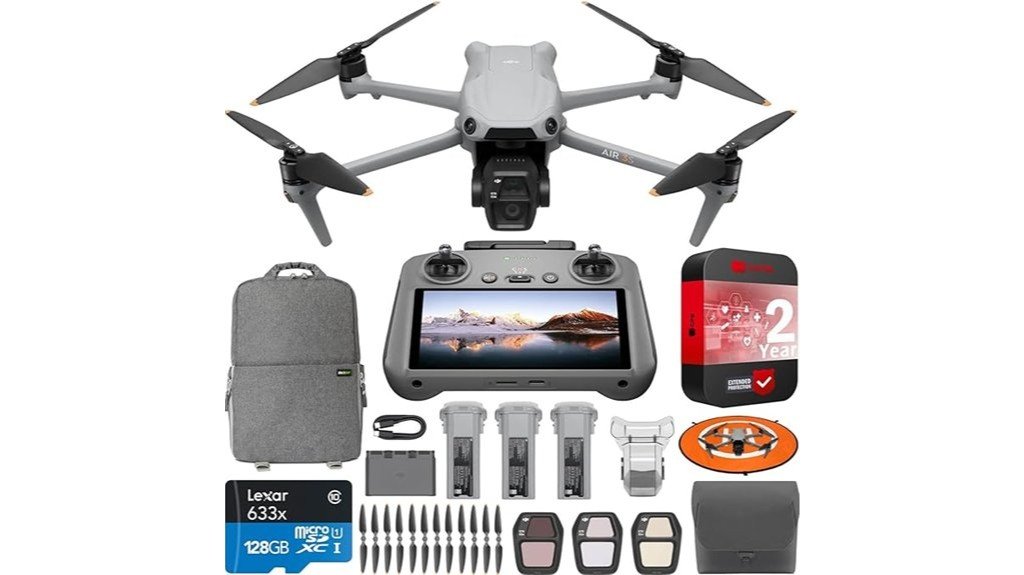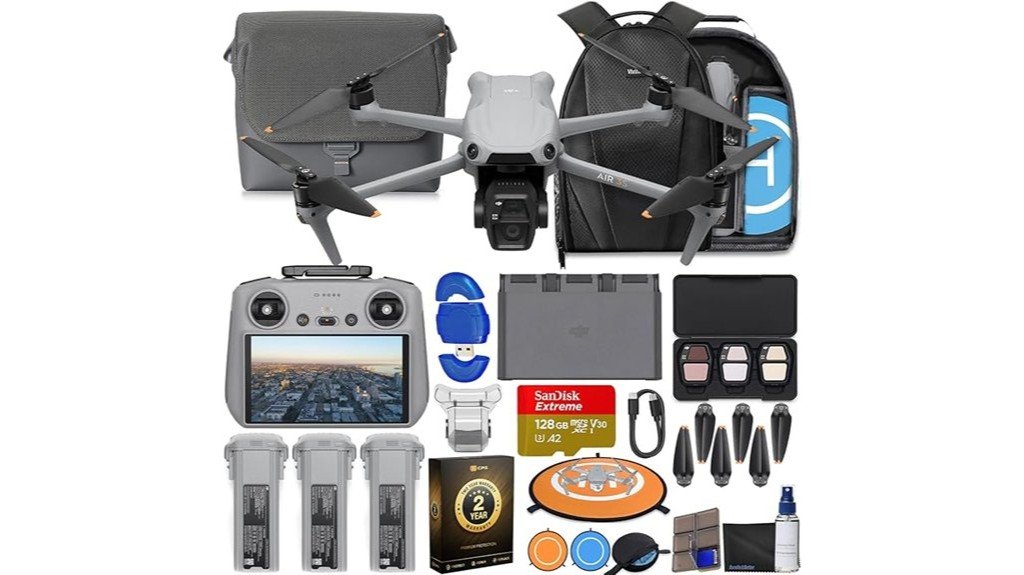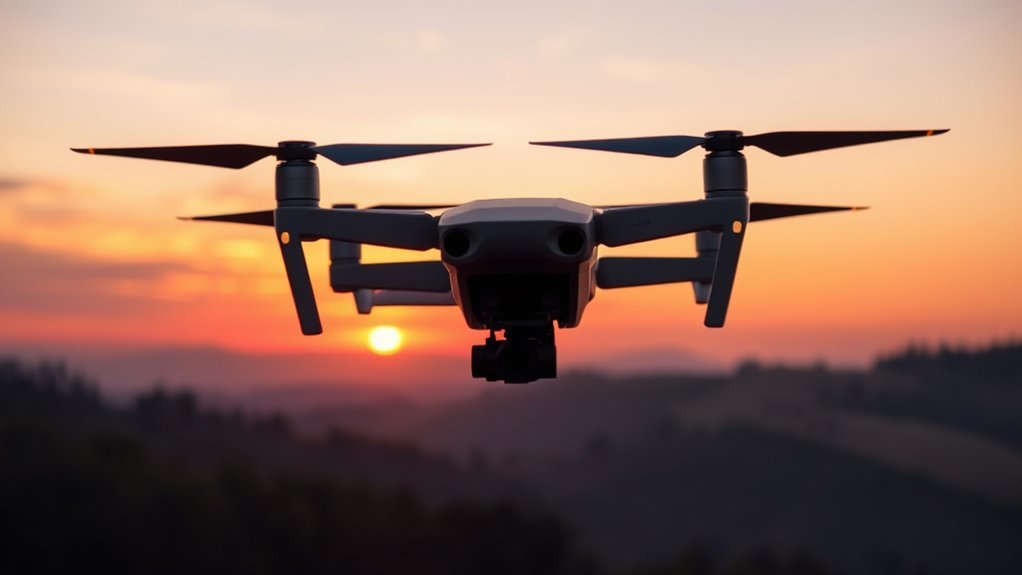As the old adage goes, “a picture’s worth a thousand words,” but what if you could take it to new heights? You’re likely looking for the best DJI drones to capture stunning aerial shots. Let’s explore the top options, starting with the DJI Air 3S – but can it live up to your expectations?
Key Takeaways
- DJI Air 3S offers 4K/60fps video resolution.
- DJI Mavic 2 Pro includes a Hasselblad Camera.
- High image quality is crucial for photography.
- Omnidirectional sensing enhances safety and stability.
- Dynamic range of 14 stops captures detail perfectly.
DJI Air 3S Fly More Combo Drone with 4K/60fps & Omnidirectional Sensing

If you’re a photographer looking for a top-notch drone, the DJI Air 3S Fly More Combo is a great choice, thanks to its impressive 4K/60fps video resolution and omnidirectional sensing. You’ll get enhanced low-light performance and 14 stops dynamic range. The drone weighs 724 grams and has a max flight time of 45 minutes, making it suitable for travel shots and seamless panoramic captures with its Free Panorama Mode.
DJI Mavic 2 Pro Drone Quadcopter with Hasselblad Camera

The DJI Mavic 2 Pro Drone Quadcopter with Hasselblad Camera stands out as a top choice for professional photographers and videographers who demand exceptional image quality. You’ll get 20MP stills and HDR 4K video with a 3-axis gimbal for steady shots. With a max speed of 44 mph and up to 31 minutes of flight time, you can capture stunning aerial shots with ease.
DJI Air 3S Drone with RC and Accessories

DJI’s Air 3S Drone with RC and Accessories stands out for its impressive 4K HDR video capture at 60fps, making it an excellent choice for photographers who demand high-quality visuals. You’ll get a model with omnidirectional obstacle sensing and a six-antenna array. It weighs 7.4 pounds and has a max flight time of 45 minutes, allowing you to capture stunning aerial shots with ease.
Factors to Consider When Choosing a DJI Drone for Photography
You’re looking for a DJI drone that meets your photography needs, and it’s essential to consider key factors. When choosing a drone, you’ll want to think about image quality, flight time, and sensor size, as these specs will impact your photos. You should also consider video resolution and obstacle sensing capabilities to ensure you get the best possible shots with your DJI drone.
Image Quality
High-quality images are crucial for photography, and several factors contribute to a drone’s ability to capture stunning photos. You’ll want to look for drones with high effective still resolution, such as 48MP or higher, and a large camera sensor size, like 1” CMOS, for better low-light performance. Advanced features like HDR and adjustable apertures can also enhance image quality. A 3-axis gimbal helps stabilize the camera, resulting in smoother photos. Additionally, consider the drone’s video resolution capabilities, such as 4K/60fps, for high-quality footage suitable for professional projects. These factors will help you choose a DJI drone that meets your photography needs.
Flight Time
When choosing a DJI drone for photography, flight time is a critical factor to consider, as it directly impacts the duration of your shooting sessions. You’ll want a drone that can stay airborne long enough to capture all the shots you need. Drones like the DJI Air 3S can fly for up to 45 minutes, while others may have shorter flight times, like 31 minutes. Considering factors like wind and payload weight will help you plan your shoots, especially in remote areas where battery replacement isn’t easy. This helps you strategize and make the most of your aerial photography sessions.
Sensor Size
Flight time’s impact on your photography sessions is significant, but it’s just one piece of the puzzle – sensor size is another key factor that can make or break your aerial photography experience. You’ll want a drone with a large sensor to capture more light and produce better low-light performance. A 1-inch CMOS sensor is ideal for professional photography, offering a notable advantage in dynamic range and color accuracy. It also allows for greater control over depth of field, enabling you to create more aesthetically pleasing images with blurred backgrounds. You should consider a drone’s sensor size when choosing the best DJI drone for your photography needs.
Video Resolution
As you consider a DJI drone for photography, you’ll find that video resolution plays a critical role in capturing stunning footage. You’ll want a drone that can record at least 4K resolution at 60 fps for sharp images. A higher dynamic range, like 14 stops, is also essential for better detail retention. Additionally, features like 10-Bit D-Log M and HLG color modes give you flexibility in post-production. The camera’s low-light performance is also crucial for capturing vibrant colors during dusk or nighttime shoots. With the right video resolution, you can create stunning aerial shots with ease.
Obstacle Sensing
You’ll want a DJI drone that can detect obstacles from all sides, and that’s where obstacle sensing technology comes in – it utilizes multiple sensors to enhance safety during flight and reduce the risk of collisions. This feature gives you confidence to focus on capturing images without worrying about crashes. Some drones have omnidirectional obstacle sensing, detecting obstacles in all directions, which is useful in tight spaces. Effective obstacle sensing improves flight stability and navigation, especially in challenging weather or unfamiliar locations, allowing you to capture stunning aerial shots with ease.
Weight Capacity
Several key factors come into play when considering a DJI drone’s weight capacity for photography. You’ll want a drone that can carry your camera equipment without compromising flight performance. Heavier drones often have more powerful motors, allowing for smoother footage. However, they typically have shorter flight durations due to increased energy consumption. When choosing a drone, consider the total weight, including any additional payload, to ensure it’s within the manufacturer’s specified maximum takeoff weight. This helps you select a drone that balances portability with the ability to carry essential equipment effectively.

